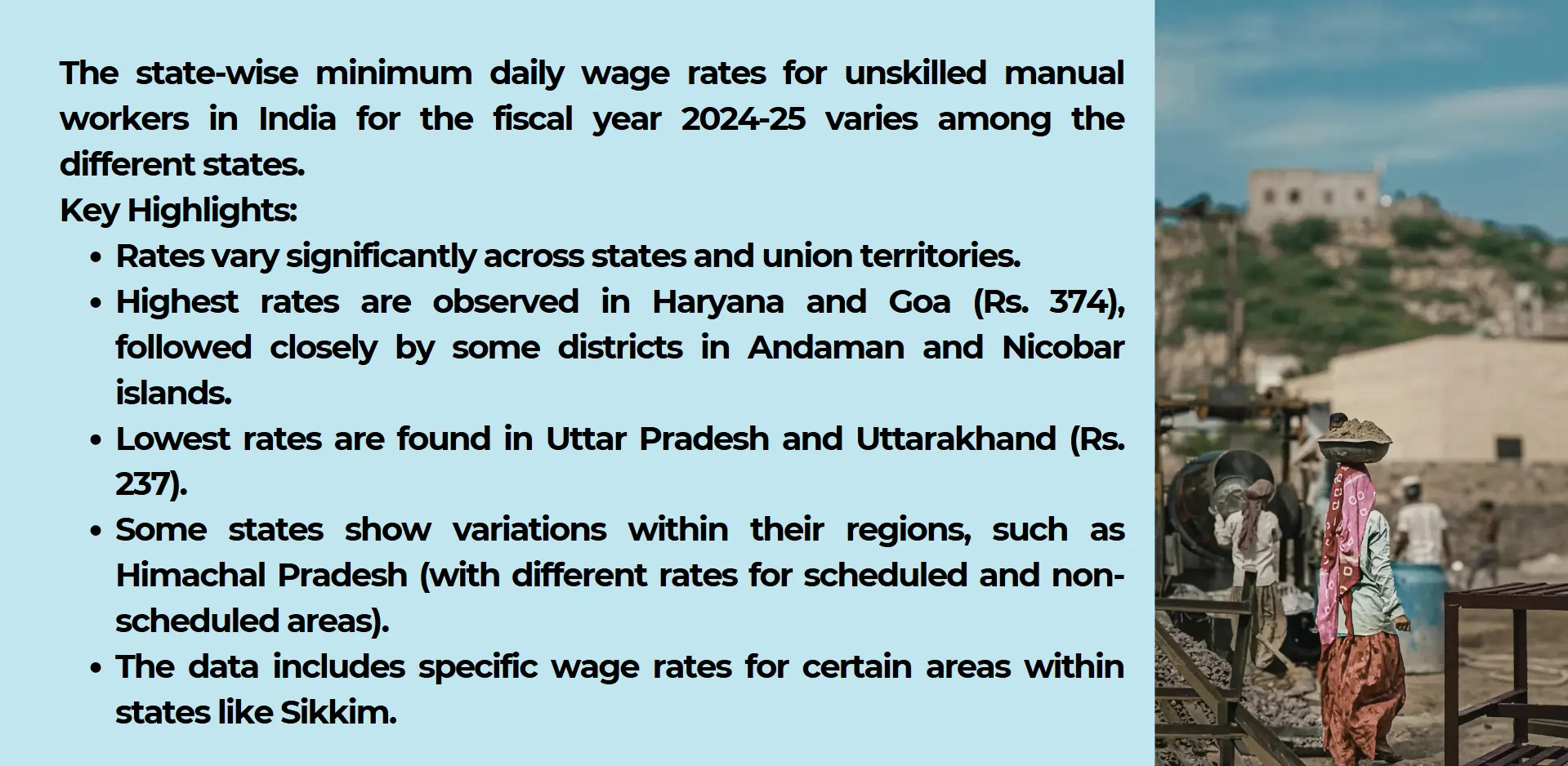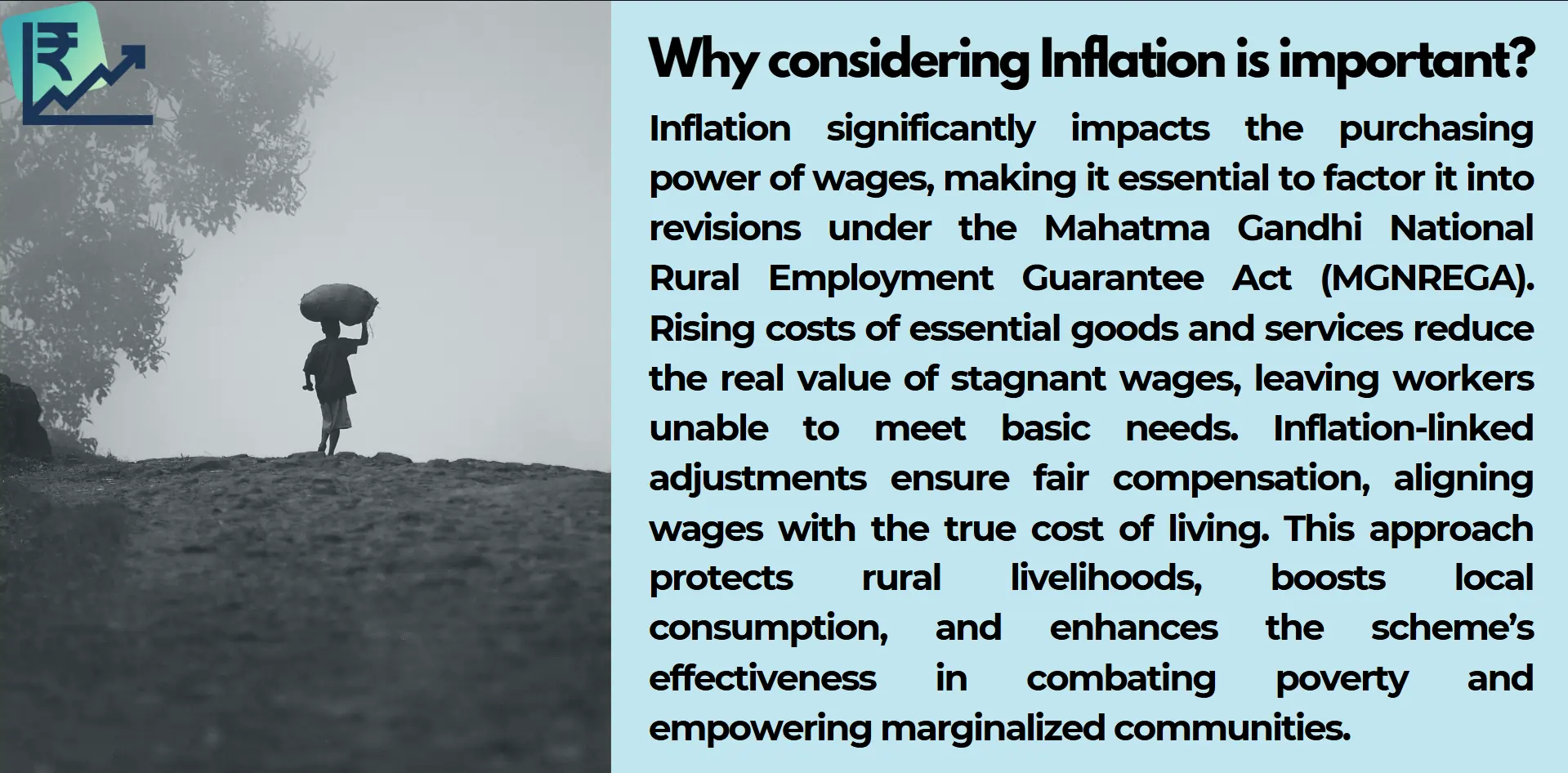There is a major problem with the Mahatma Gandhi National Rural Employment Guarantee Act (NREGA) wages in India so the program requires a revision to address these issues.

As one of India’s largest social welfare programs NREGA functions to secure rural households' livelihoods and provide guaranteed employment for rural families. The initiative creates employment to prevent poverty while lowering inequality and giving power to disenfranchised communities. A fundamental obstacle has developed with respect to NREGA wage rates being insufficient during recent years. The constant decline in real wage value due to inflation combined with rising living costs has made wage rate revision a critical matter for rural families. Wage rates that differ by state create extra difficulties when implementing the program. The solution to this matter is vital for looking after millions of workers' economic situation since it also ensures the credibility and effectiveness of the entire program. NREGA wage revisions will facilitate social justice along with societal development for all sections of society.
Current Status of NREGA Wage Rates
Through the NREGA rural households obtain vital livelihood security. The wage rate under this program remains under investigation by various stakeholders.
State-Wise Wage Variations
Different states maintain different wage rates under NREGA because economic resources differ greatly from region to region. Haryana stands out by offering ₹374 as its NREGA wage rate whereas Nagaland distributes only ₹234. Equitable benefits for workers across the nation require standardization because the wage discrepancies have become apparent.

Comparison with Minimum Wages
The NREGA wage levels continue to fall short of the minimum wages that are set in several states for agricultural workers. The wage difference makes it difficult for workers to receive decent life opportunities through the scheme so they must resort to unstable employment options.
Impact of Inflation
The actual value of current wages reduces because they do not rise with inflation. Serious inflation pressures push national minimum wages to stay below ₹294 while the annual rise surpasses previous years by only 5 percent. The current wage rates create difficulties for workers who need to satisfy their essential basic needs.
Challenges in Implementation
The combination of late payments together with errors in wage determination makes the issue even more troublesome. Bureaucratic barriers that workers experience turn the scheme less effective which decreases worker enrolment in it.
Need for Policy Reforms
The present state of NREGA wage rates clearly reveals the need for immediate reform measures. Wage rates should connect to inflation indexes while also improving payment timing because this will strengthen the scheme and rebuild public confidence in it.
Factors Necessitating Revision
The wages paid through the Mahatma Gandhi National Rural Employment Guarantee Act (NREGA) have faced increasing public scrutiny because they do not meet the financial requirements of rural India at present.
- Inflation: NREGA wages have become steadily less valuable because of inflation which results in NREGA workers struggling to maintain their basic needs. Essential item prices like food and education have risen significantly but wage revisions remain behind these increases. The economic situation of NREGA workers typically worsens because their wages fail to keep pace with rising costs.
- Wage Disparities across States: Another reason demanding wage rate reform occurs because different states maintain highly diverse NREGA wages. The wages in Haryana exceed those in Nagaland which pays much less. The existence of wage inequalities within NREGA interferes with the program's goal to secure equal standards of living across all social groups.
- Inadequate Livelihood Support: The existing wage levels from NREGA do not sustain workers financially because they mainly depend on this program for their survival. Households without sufficient income are tempted to find more income through traveling seasonally which leads to unstable employment.
- Impact on Rural Workforce Participation: The present wages create a barrier that prevents workers from joining NREGA activities thus making the scheme less successful in its rural employment mission. The wages need increase to attract workers while maintaining respect for manual work.
- Economic and Social Implications: Low wages create limitations for rural citizens to consume thus distorting economic development and worsening social inequalities across the country. The revision of wages serves as an important factor for reducing poverty and creating empowered rural communities with greater economic strength.
The effectiveness and credibility of NREGA depends on addressing these factors because doing so will enable the program to deliver its promised transformation as an important social welfare initiative.
Consequences of Current Wage Policy
The wages established through the Mahatma Gandhi National Rural Employment Guarantee Act (NREGA) create extensive effects on how well the program works with rural development and beneficiary welfare.
Economic Stagnation in Rural Areas
Rural workers maintain little purchasing power because the minimal wage rates stimulate little rural consumption. The scarcity of money from families prohibits them from accessing improved nutrition, education and healthcare thus negatively affects rural economic expansion.
Increased Poverty and Inequality
Workers who earn insufficient salaries cannot sustain themselves leading to long-term poverty. State-based wage disparities create social segregation that makes particular regions and communities endure excessive poverty compared to others.
Erosion of Program Credibility
Low wages under the NREGA scheme reduce both its public acceptance and the confidence citizens have in the program. Spread distrust among workers makes them either discontinue their participation or seek higher-paying urban employment which may have less job stability so the program fails to fulfil its core goal.
Underutilization of Workforce Potential
Rural workers avoid participating when pay rates remain low which leaves a vast part of eligible rural labor force unutilized throughout the year. The employment program suffers from unsuccessful delivery because its main purpose is to create productive work opportunities for unemployed rural residents.
Adverse Social Impacts
Urgently money creates social stresses that cause families to face various challenges which lead to malnutrition and poor attendance at school of children. Through these living circumstances poverty continues to grow which prevents rural areas from developing properly.
The wage policy in effect under NREGA is mismatched with real life socio-economic conditions throughout rural India. The revision of wage rates stands as a critical measure to combat unwanted effects which will help bring new life to the program's function as empowerment tool and driver of inclusive development.
Comparative Analysis
Wage policies related to the Mahatma Gandhi National Rural Employment Guarantee Act (NREGA) should incorporate better practices obtained through international historical research.
International Wage Models
The Expanded Public Works Program (EPWP) of South Africa periodically adjusts wages according to inflation rates and living standards of the population. These employment schemes provide better wages for workers which keep programs valid while achieving increased participation from workers. India faces a problem because it lacks to establish automated wage adjustment systems.
Historical Wage Trends in NREGA
The wage rates of NREGA have received occasional limited increases since its launch in 2005. The absence of regular inflation-linked policies stands in clear opposition to the standard used when India revised its Minimum Wage Act to correspond with economic changes.
State Comparisons
Workers in Haryana benefit from higher wages which leads to higher attendance when compared to wage-receiving workers in Nagaland. A unified wage policy needs immediate implementation because current disparities demonstrate this necessity in India.
Utilizing existing data will allow the enhancement of NREGA's performance alongside proper compliance with domestic and international guidelines for worker protection.
Arguments
The majority of society backs modifications to NREGA financial compensation yet multiple difficulties emerge when trying to put these changes into practice. A transformation of NREGA demands the resolution of operational problems to gain validity.
Fiscal Strain on Government Finances
Some critics believe the government budget suffers potential damage because of increased NREGA program wage allocations. The substantial financial commitment toward the scheme requires attention because opponents strongly oppose any budget cutbacks that could affect other development programs' operations. Rising initial spending needed to boost worker wage levels does not create obstacles because the program's enhanced long-term rural spending and poverty alleviation produce greater spending outcomes. Workplace spending effectiveness combined with the selection of essential welfare programs creates financial stability.
Risk of Inflation
The concern about inflation emerges because NREGA workers serve as a fundamental rural workforce whose wage increases could potentially affect market prices. The critics point out that wage modifications create a potential reduction in total outcomes. Wages adjusted by inflation indices make economic sense by preventing major price surges. Regular wage review processes reduce inflation threats compared to dramatic wage adjustments.
Dependency Concerns
NREGA wage elevations have raised doubt regarding how workers might abandon other employment options because they rely solely on the program benefits. Skill development programs along with adjusted wages represent an answer to overcome current employment challenges. Workers participating in this scheme can create rising earning opportunities to diminish their NREGA dependency through developing economic potential.
Administrative Challenges
The critics express concerns that adjusting minimum wages could cause operational and administrative problems. The quality of wage modifications strongly impacts how payment delays and data inaccuracies evolve between implementation and execution. Digital payment systems supported by technology create effective transparency and operational efficiency that decreases administrative workload. Effective accountability measures will maximize the delivery quality of wage policy execution.
Policy Recommendations
Immediate implementation of strategic reforms stands as the solution to fix NREGA wage policy problems currently affecting the program. The collection of suggested reforms seeks to optimize the operational strategies and protect fair rural growth outcomes.
Linking Wages to Inflation
Officials should implement an inflation adjustment system which relies on the Consumer Price Index (CPI) to modify NREGA work pay. Automatic periodic wage rate revisions allow life cost modifications to flow through payments to workers. The method allows workers to maintain their purchasing power especially during periods of abnormal price inflation.

Standardizing Wage Rates
Nations should adopt a uniform wage system although economic conditions between areas should stay acknowledged. A national wage standard should exist because states must not diminish wage levels which risk worker health. The program seeks to reduce existing wage differences between all states operating in the Country.
Ensuring Timely Payments
Workers must get their payments immediately in order to develop sufficient trust in participating in the program. A technology-based transfer system using Aadhaar bank links maintains both the transparency and operational efficiency of payment procedures. A rapid wage distribution system will boost employee motivation together with their commitment to the program.
Increased Budget Allocation
Additional funding allocations from the government will allow NREGA to provide guaranteed higher wages to beneficiaries. Extra funding would enable both increased compensation and expanded opportunity openings for beneficiaries under the scheme.
Periodic Review and Evaluation
The NREGA operational adjustments must result from periodic evaluations conducted by an independent institution focused on wage assessment. A thorough evaluation procedure allows the scheme to adjust its operations based on shifts in social economic conditions.
Skill Development Integration
The combination of India Skills Report training alongside salary assurance will improve rural productivity over extended periods. Through built-in time intervals workers can shift toward earning higher wages thus diminishing their requirement for NREGA benefits.
Conclusion
Wage rate adjustments for NREGA are necessary because they will improve rural lifestyle standards and fight poverty and strengthen program quality. The current wage policy of NREGA fails to deliver social welfare because it ignores adjustments to inflation rates, local price variations and rising living expenses. The complete ability of NREGA to strengthen rural communities demands wage and payment rate reforms which incorporate inflation adjustment schemes. Legislators must prioritize revisions as their top priority to develop both economic expansion that includes everyone and societal fairness.